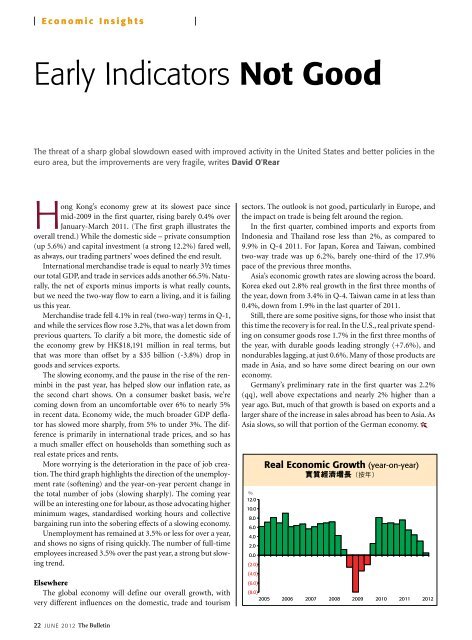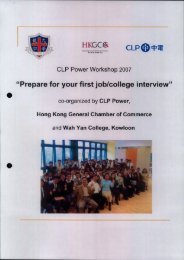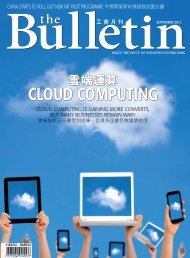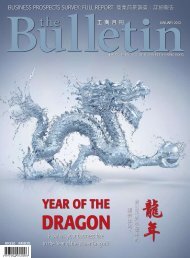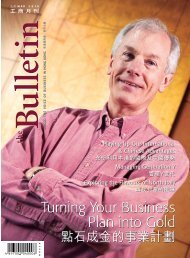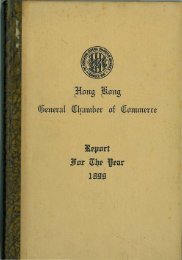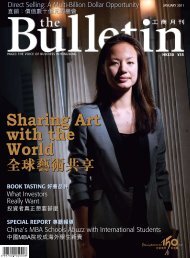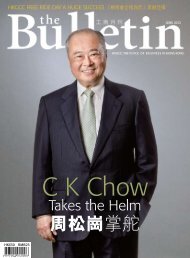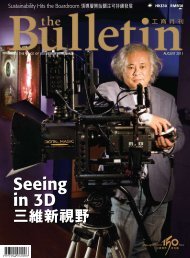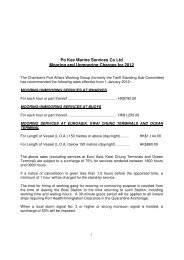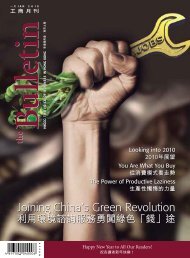é¦æ¸¯ç¸½åæå ¨ç¨çºæ¨ - The Hong Kong General Chamber of Commerce
é¦æ¸¯ç¸½åæå ¨ç¨çºæ¨ - The Hong Kong General Chamber of Commerce
é¦æ¸¯ç¸½åæå ¨ç¨çºæ¨ - The Hong Kong General Chamber of Commerce
You also want an ePaper? Increase the reach of your titles
YUMPU automatically turns print PDFs into web optimized ePapers that Google loves.
| Economic Insights 經 濟 透 視 |Early Indicators Not Good早 期 指 標 不 樂 觀<strong>The</strong> threat <strong>of</strong> a sharp global slowdown eased with improved activity in the United States and better policies in theeuro area, but the improvements are very fragile, writes David O'Rear隨 著 美 國 經 濟 活 動 好 轉 及 歐 元 地 區 推 出 更 適 切 的 政 策 , 全 球 急 劇 放 緩 的 威 脅 已 經 緩 和 , 但 有 關 改 善 非 常 薄 弱歐 大 衛<strong>Hong</strong> <strong>Kong</strong>’s economy grew at its slowest pace sincemid-2009 in the first quarter, rising barely 0.4% overJanuary-March 2011. (<strong>The</strong> first graph illustrates theoverall trend.) While the domestic side – private consumption(up 5.6%) and capital investment (a strong 12.2%) fared well,as always, our trading partners’ woes defined the end result.International merchandise trade is equal to nearly 3½ timesour total GDP, and trade in services adds another 66.5%. Naturally,the net <strong>of</strong> exports minus imports is what really counts,but we need the two-way flow to earn a living, and it is failingus this year.Merchandise trade fell 4.1% in real (two-way) terms in Q-1,and while the services flow rose 3.2%, that was a let down fromprevious quarters. To clarify a bit more, the domestic side <strong>of</strong>the economy grew by HK$18,191 million in real terms, butthat was more than <strong>of</strong>fset by a $35 billion (-3.8%) drop ingoods and services exports.<strong>The</strong> slowing economy, and the pause in the rise <strong>of</strong> the renminbiin the past year, has helped slow our inflation rate, asthe second chart shows. On a consumer basket basis, we’recoming down from an uncomfortable over 6% to nearly 5%in recent data. Economy wide, the much broader GDP deflatorhas slowed more sharply, from 5% to under 3%. <strong>The</strong> differenceis primarily in international trade prices, and so hasa much smaller effect on households than something such asreal estate prices and rents.More worrying is the deterioration in the pace <strong>of</strong> job creation.<strong>The</strong> third graph highlights the direction <strong>of</strong> the unemploymentrate (s<strong>of</strong>tening) and the year-on-year percent change inthe total number <strong>of</strong> jobs (slowing sharply). <strong>The</strong> coming yearwill be an interesting one for labour, as those advocating higherminimum wages, standardised working hours and collectivebargaining run into the sobering effects <strong>of</strong> a slowing economy.Unemployment has remained at 3.5% or less for over a year,and shows no signs <strong>of</strong> rising quickly. <strong>The</strong> number <strong>of</strong> full-timeemployees increased 3.5% over the past year, a strong but slowingtrend.sectors. <strong>The</strong> outlook is not good, particularly in Europe, andthe impact on trade is being felt around the region.In the first quarter, combined imports and exports fromIndonesia and Thailand rose less than 2%, as compared to9.9% in Q-4 2011. For Japan, Korea and Taiwan, combinedtwo-way trade was up 6.2%, barely one-third <strong>of</strong> the 17.9%pace <strong>of</strong> the previous three months.Asia’s economic growth rates are slowing across the board.Korea eked out 2.8% real growth in the first three months <strong>of</strong>the year, down from 3.4% in Q-4. Taiwan came in at less than0.4%, down from 1.9% in the last quarter <strong>of</strong> 2011.Still, there are some positive signs, for those who insist thatthis time the recovery is for real. In the U.S., real private spendingon consumer goods rose 1.7% in the first three months <strong>of</strong>the year, with durable goods leading strongly (+7.6%), andnondurables lagging, at just 0.6%. Many <strong>of</strong> those products aremade in Asia, and so have some direct bearing on our owneconomy.Germany’s preliminary rate in the first quarter was 2.2%(qq), well above expectations and nearly 2% higher than ayear ago. But, much <strong>of</strong> that growth is based on exports and alarger share <strong>of</strong> the increase in sales abroad has been to Asia. AsAsia slows, so will that portion <strong>of</strong> the German economy.Elsewhere<strong>The</strong> global economy will define our overall growth, withvery different influences on the domestic, trade and tourism22 June 2012 <strong>The</strong> Bulletin 工 商 月 刊


